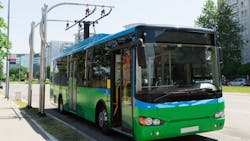Moving from a shared vision to strategic alignment is key to progress on electrification
While leaders and countries around the world continue to grapple with how to most effectively tackle climate change as we begin 2024, the most populous state in the U.S. believes that electrification will be key to doing so.
Economy-wide, the Biden-Harris Administration has set a goal to reach carbon neutrality by 2050 while California has committed to reaching this goal by 2045. In California alone, the transportation sectoraccounts for roughly 50 percent of the state’s total greenhouse gas emissions. To address this, the state has set a goal of transitioning all bus fleets to 100 percent zero-emissions by 2040.
The conventional thinking around lowering transportation emissions is that you simply need to increase the fleet of zero-emission vehicles and get them on the roadbut it’s not just about the vehicles. While new electric vehicle (EV) technology will continue to spark excitement, the real battle is with the infrastructure that it will connect to. Due to supply chain difficulties, pending grid updates and the lack of broader supporting infrastructure, only two percent of transit buses on the road today are zero-emissions vehicles. If we are to reach 100 percent zero-emissions by 2040, stakeholders must begin viewing the advancement of electrification infrastructure as equally critical to getting EVs on the road.
The fact that the vision for climate action is shared by public and private sectors, federal, state and local politicians and consumers is both promising and energizing. However, the challenge of turning talk into action remains. How can massive American cities such as Los Angeles effectively reshape their infrastructure to accomplish these important goals?
The shared vision
To answer that, let’s first look at what has generated this call to decarbonize.
Certainly, there is political will at the national and state levels. Both the Infrastructure Investment and Jobs Act (IIJA) and the Inflation Reduction Act (IRA) provide billions of dollars to spur domestic EV manufacturing and adoption and, importantly, support the buildout of electrification infrastructure. Late in 2023, California Gov. Gavin Newsom extended California’s Clean Transportation Program, which is critical for both advancing charging and refueling infrastructureprojects and safeguarding the health and well-being of residents.
Another source of momentum driving electrification are the growing calls by those disproportionately affected by poor transit access and unclean transportation systems. While the IRA’s EV rebates and incentives may lessen the burden of going clean, many people still cannot afford to individually transition to a costlier EV.
Traditionally, successful transit was measured by the number of riders, stations and resulting fare revenue. Today, there’s a much bigger focus on connecting communities and providing people with opportunities beyond their neighborhoods. Being thoughtful about where clean transit goes is just as important as building the infrastructure and technology in the first place. In Minneapolis, Minn., and Miami, Fla., AECOM is looking at every bus route to understand the positive community impact zero-emissions transit can have on the neighborhoods it serves. A similar activity would be important for Los Angeles, as 16 of the top25 most ozone-polluted counties in the U.S. are in California, including Los Angeles County (3rd). Angelenos recognize that infrastructure improvements would yield better transit and greater health equity for all communities and are making their voices heard.
The need for strategic alignment
With that shared vision for decarbonization and electrification in mind, how can cities and countries make those dreams a reality? It starts with strategic alignment.
Take Los Angeles, Calif., for example. I often refer to it as a “city of cities,” meaning several other major towns revolve around and rely upon the downtown area. This means that what the city does on transit will directly affect how the surrounding county approaches this complicated task. Several different transit agencies currently run their buses through the city so building out electrification infrastructure will directly benefit others that rely on the downtown landscape. This interdependence among regional stakeholders can – if approached thoughtfully – allow the city to effectively serve a diverse host of fleet owners.
However, with great opportunity comes great challenges. Electrifying Los Angeles is a much different task than building up state-of-the-art electrification and transit infrastructure in a brownfield or greenfield setting. AECOM knows this firsthand, having supported Qatar’s Ministry of Transport as the lead design firm tasked with developing public bus infrastructure facilities to support enhanced public bus network operations around the 2022 World Cup. This was critical in ensuring Qatar hosted the first carbon-neutral World Cup in history. But even now, after the tournament, Qatar has one of the largest zero-emissions transit facilities in the world and has begun to build a legacy around electrification.
Los Angeles, on the other hand, has to adjust an entire transportation and grid ecosystem while continuing to serve the needs of millions of people on a daily basis. Because of all this, the strategic alignment between public and private stakeholders around infrastructure efforts in Los Angeles is absolutely critical.
Three things Los Angeles can do to electrify
While the path to electrification for Los Angeles is certainly daunting, it is a challenge that should energize public officials and citizens. These are three things Los Angeles, and similar jurisdictions, can do to successfully electrify.
1. Develop partnerships
A more resilient, sustainable transportation network requires a multi-faceted network with all partners pulling in the same direction. Activities from different players need to be layered in a way that yields the best chance to accelerate progress toward zero-emissions. Los Angeles would be well served to take a step back and conduct a master planning exercise to plot this path, as working in silos will create unproductive conflicts and redundancies.
The alignment and partnership that master planning brings would also build awareness on cross-department benefits. For example, while zero-emissions buses provide clean, reliable transport, they can also serve as mobile power generators to provide energy resiliency to the grid in times of need.
2. Prioritize decarbonization activities
Prioritization is a key step in the master planning process. Communities typically have a shared vision for the future but the organizations and departments tasked with implementing solutions often have differing and nuanced near-term priorities.
It’s important to remember that no single organization or individual has all the answers. Prioritization and collaboration identifies the most important steps, generates collective wisdom and mobilizes organizations to efficiently and effectively drive toward shared outcomes.
3. Build with a long-term view
When embarking on major infrastructure and building projects, it is essential that they leave a positive legacy for the surrounding community. Cross-jurisdictional and cross-agency partnerships are key to making that happen.
A great opportunity for Los Angeles to do this comes in the form of the 2028 Olympic and Paralympic Games, as 2028 will mark the third time the city has hosted the games, an honor matched only by Paris. However, in addition to the athletic legacy, the city retains excellent infrastructure built over the years. Capitalizing on the existing assets, Los Angeles can instead focus on thoughtfully building additional assets that provide long-term benefits well past the conclusion of the games. In short, the approach should be to fit the games to the city, not the city to the games.
No city like Los Angeles has gone through this type of transition yet. Transforming an area that’s bustling with nearly 10 million people, in addition to adjusting the transportation and grid ecosystem is both a difficult challenge and an exciting opportunity.
About the Author

Andrew Bui
AECOM’s global bus and zero-emissions lead
Andrew Bui is AECOM’s global bus and zero-emissions lead, focused on supporting cities, transit agencies, fleet owners and infrastructure owners and operators transition to zero emissions vehicles. Andrew works with clients across the globe on developing strategies focused on efficiently deploying and scaling zero-emission technologies for fleet and infrastructure owners.
